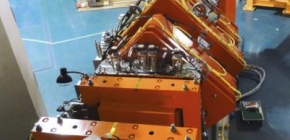
Development on Muon Beam Analysis of Organic Matter in Samples from Space
Japanese researchers from Osaka University have developed a muon-based approach to non-destructive investigations for unique asteroid samples
Muon has much higher transmissivity than electrons and X-rays. This feature of muon has enabled us to see through volcanoes, pyramids, and nuclear reactors with cosmic-ray induced natural muons. The artificial muon beam in acceleration facilities also has huge potential for material science. It has already been shown that the muon beam can look inside extraterrestrial samples (Terada et al. 2014, Scientific Reports https://www.nature.com/articles/srep05072 ).
Recently, Osaka University has established a world-leading intense direct current muon beam source (MuSIC; MUon Science Innovative Channel), and succeeded in obtaining bulk abundances of major elements in a centimeter-sized chip of a carbonaceous chondrite, Jbilet Winselwan, related to the asteroid samples expected back from space missions in the 2020s. Their study was reported in Scientific Reports ( https://www.nature.com/articles/s41598-017-15719-5 ).
The non-destructive classification of extraterrestrial samples and determination of their carbon content can be a novel powerful approach for primary characterization of samples returned by spacecraft. In particular, this technique will be quite useful to characterize millimeter- to centimeter-sized samples that will be returned from carbonaceous asteroids by Hayabusa2 (2014–2020) and OSIRIS-REx (2016–2023) because the samples are expected to contain extraterrestrial organics.
Lead author Prof. Kentaro Terada says, “We are particularly interested in the organic content of these asteroid samples. It is important to measure the Muonic carbon X-ray signal from inside of the representative carbonaceous chondrites without any destruction.”
This non-destructive elemental analytical technique will be a great innovative breakthrough not only in Earth and Planetary Science but also in various research fields, such as Archeology, Material Science, and Social Sciences.
Co-author Dr. Akira Sato, who is in charge of the muon beam line, says, “Through these trials we have learned a lot about muon-based analysis and identified the areas that still need some further improvements. Our non-destructive elemental analysis can be applied to archaeological and museum artifacts, which require non-destructive analysis due to their value or scarcity. We can also study distribution of chemical components in a working Lithium ion battery with this method”.

Fig. 1: An entire view of the MuSIC ( Mu on S cience I nnovative C hannel) beam line at RCNP (Research Center for Nuclear Physics), Osaka University (credit: Osaka University)

Fig. 2: Concept of Muonic Characteristic X-ray (credit: Osaka University)

Fig. 3: Comparison of CI-normalized C/Si and Fe/Mg ratios of Jbilet Winselwan with those of different chemical groups of chondrites (credit: Osaka University)
To learn more about this research, please view the full research report entitled " Non-destructive elemental analysis of a carbonaceous chondrite with direct current Muon beam at MuSIC " at this page of Scientific Reports .
Related links
